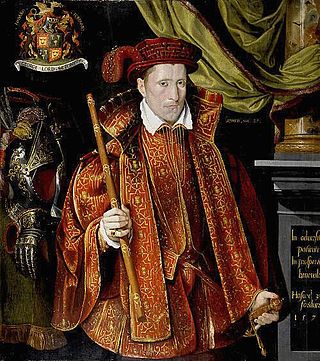


Henry Nisbet (1535–1608) was a 16th-century Scottish merchant and Provost of Edinburgh for 1597/98. [1]



Henry Nisbet (1535–1608) was a 16th-century Scottish merchant and Provost of Edinburgh for 1597/98. [1]
The son of Adam Nisbet and Elizabeth Hay, daughter of the 3rd Lord Hay, [2] he became a textile merchant, haberdasher and clothier in Edinburgh. In 1587 he supplied Ambassador Eustache de Courcelles with violet crimson velvet for his attendants' clothes, mourning cloth at death of Mary, Queen of Scots, a beaver hat, silk points and ribbon for the Ambassador's shoes, and other court dress. Nisbet also advanced the French ambassador large sums of money. [3]
Acting as an envoy, Nisbet delivered royal letters to Charles IX of France in April 1583 requesting tax relief for Scottish merchants, and then HM letter in reply to Esmé Stewart, 1st Duke of Lennox. [4]
Nisbet served as Provost of Edinburgh for 1597/98. In July 1598 Nisbet was a member of a committee of lawyers and ministers including Sir John Preston of Fentonbarns, the Revd Robert Rollock and John Russell who devised a syllabus for the University of Edinburgh comprising readings from Latin authors. [5]
Resident in an Edinburgh townhouse on the High Street, in 1609 his son bought from the estate of Lord Lindsay the feudal barony of Dean just west of Edinburgh, where the Nisbets built a mansion which survived until the 19c, and is now where the Dean Cemetery is situated. [6]
The National Museum of Scotland has painted ceiling fragments from the gallery of Dean House depicting the Sacrifice of Isaac, Judith, and other subjects. The paintings may date from the time of his son, Sir William Nisbet. [7] A carved pediment for a window was inscribed; "H. N." for Henry Nisbet displaying the Nisbet arms, and a stone panel with "I. B." and the Bellenden arms for his wife, Janet Bellenden. [8]
After Henry Nisbet died in 1608, his sons obtained permission from the Burgh to erect a monument in his memory. [9]
Nisbet married Janet Bellenden (d. 1621), aunt of Lord Bellenden, leaving issue including:

Restalrig is a small residential suburb of Edinburgh, Scotland. It is located east of the city centre, west of Craigentinny and to the east of Lochend, both of which it overlaps. Restalrig Road is the main route through the area, running from London Road, at Jock's Lodge, to Leith Links. It is in the ward of Lochend.
George de Lawedreof Haltoun was a Burgess and Provost of Edinburgh in the early 15th century.
Bishop Adam Bellenden was a 17th-century Scottish churchman serving the Church of Scotland and rising to be Bishop of Aberdeen.

Thomas Burgh, 3rd Baron Burgh of Gainsborough,, de jure 7th Baron Strabolgi and 9th Baron Cobham of Sterborough, was the son of William Burgh, 2nd Baron Burgh and Lady Katherine Clinton, daughter of Edward Clinton, 1st Earl of Lincoln and Elizabeth Blount, former mistress of King Henry VIII. He was one of the peers who conducted the trial of the Duke of Norfolk in 1572.

George Seton V, 7th Lord Seton (1531–1586), was a Lord of the Parliament of Scotland, Master of the Household of Mary, Queen of Scots, and Provost of Edinburgh. He was the eldest son of George Seton, 6th Lord Seton, and Elizabeth Hay, a daughter of John Hay, 3rd Lord Hay of Yester. His childhood and schooling were in France.
Sir Archibald Napier was a Scottish landowner and official, master of the Scottish mint and seventh Laird of Merchiston.
Francis Bothwell of Edinburgh, Lord of Session, was a Scottish merchant, landowner, judge and politician. As a university graduate, he was called Master Francis Bothwell, or "Dominus" in Latin documents; however, this has been misunderstood by some writers, so he is occasionally, inaccurately, referred to as "Sir" Francis Bothwell.
Sir John Preston, Lord Fentonbarns, of Penicuik, was a Scottish lawyer and judge who became lord president of the court of session.
Jean Fleming, Countess of Cassilis (1553/4–1609) was a Scottish noblewoman and courtier at the court of James VI of Scotland, and a survivor of domestic violence.
Sir William Nisbet of Dean was a 16th/17th century Scottish merchant who twice served as Provost of Edinburgh from 1616 to 1619 and 1622 to 1623.
Nicholas (Nicol) Uddert or Udward or Udwart or Anglicised as Nicol Edward was a 16th century Scottish merchant who served as Provost of Edinburgh in 1592/93.
John Arnot of Birswick (Orkney) (1530–1616) was a 16th-century Scottish merchant and landowner who served as Lord Provost of Edinburgh from 1587 to 1591 and from 1608 to death. He was Deputy Treasurer to King James VI.
Marguerite Wood was a Scottish historian and archivist who specialised in Scottish history. She served as Keeper of the Burgh Records of Edinburgh and was a Fellow of the Royal Historical Society and a member of the Scottish Records Advisory Council.
Patrick Nisbet, Lord Eastbank (1565–1648) was a long-lived 17th century Scottish landowner, judge and Senator of the College of Justice.
Robert Jousie was a Scottish textile merchant, financier, and courtier. He was involved in the collection and administration of the English subsidy of James VI.
Alexander Clark of Balbirnie was a Scottish merchant and Provost of Edinburgh. He was closely involved with English diplomacy.
William Fairlie or Fairley was an Edinburgh merchant and burgess.
John Kinloch or Killoch was keeper of the royal tennis courts, a post master and stable owner in 16th-century Edinburgh and the proprietor of house used for lodgings and banquets.

Alexander Oustean or Oustian or Austin was a Scottish tailor and member of Edinburgh burgh council.
John Russell (1550–1613) was a Scottish lawyer and author, who acted at the 16c witch trials.